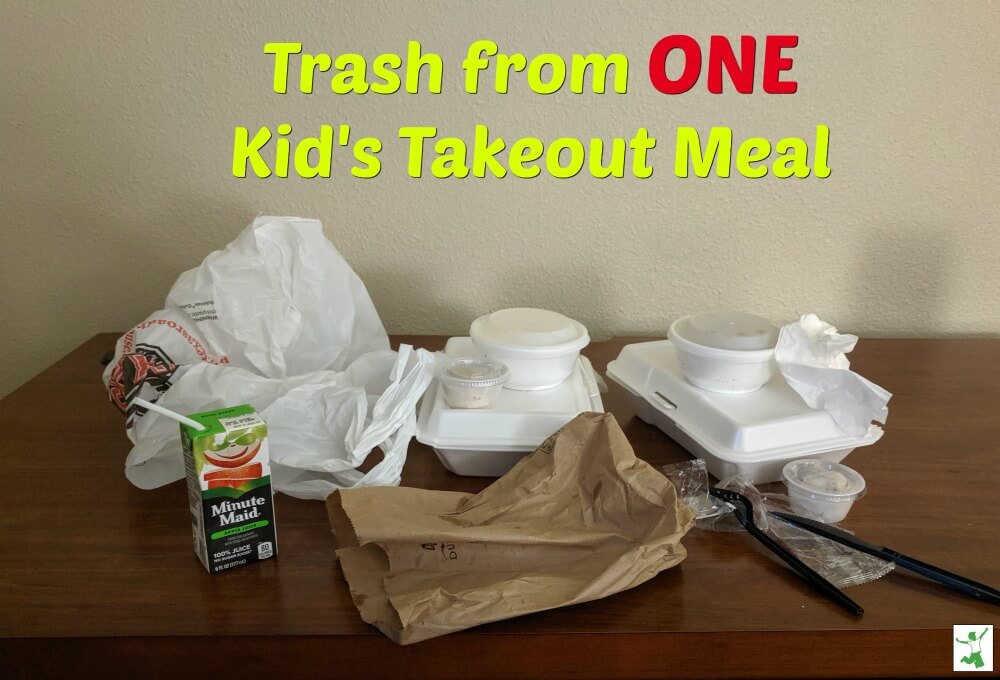Table of Contents[Hide][Show]
 There are certainly few things in American life more convenient than takeout.
There are certainly few things in American life more convenient than takeout.
The rise of Grubhub, Uber Eats, Bite Squad, Door Dash and a few others has made the process even easier. Now, you don’t even have to leave your house to get takeout food…or takeaway as some folks call it.
Takeout Truths
I began to seriously rethink my relationship with takeout on a trip to the EU a couple of summers ago.
For most of our visit, we stayed in Valkenburg, a quaint little village in the Netherlands with the picturesque ruins of a medieval castle perched high on a hill. It is located a very short drive from the border with Germany and Belgium.
The village center had a number of excellent restaurants within walking distance of our small hotel.
On some days, we returned from our excursions quite worn out, rather unwilling to go and sit in a restaurant for a meal.
Takeout seemed very appealing on those days!
On one particular afternoon, I went to get takeaway for my son and myself. I was shocked when I was told that the restaurant had no plastic utensils or straws.
The staff used only a small paper bag to package up the food. There was no styrofoam or plastic whatsoever.
When I got back to the hotel, I borrowed some silverware from the front desk to eat with. The maid collected it the next morning when our room was cleaned.
Takeaway Trash
That simple experience got me to thinking…why do some countries get by just fine without the plastic utensils, straws, and styrofoam included with the approximately 5.5 million takeout meals prepared every day in the United States? (1)
This convenience comes with a huge environmental price.
Many people believe that this plastic is mostly recycled. I used to think this too!
As it turns out, a staggering 91% of plastic isn’t reused at all. It ends up in our waterways or polluting the shores of third world countries. (2)
Those plastic bags that you diligently take to the supermarket recycling bins to avoid using reusable bags? Yeah, the majority of those are exported too due to contamination. (3)
The hard truth is that recycling has not reduced the amount of new plastic produced each year. The amount surged from 15 million tons in 1964 to 311 tons in 2014—an increase of more than 2,000 percent. (4)
With waste management facilities overwhelmed and no profitable market to sell plastic waste, countries resort to exporting it across our vulnerable oceans.
Out of sight is definitely NOT out of mind.
Once the oil guzzling barges unload the dirty, smelly trash, third-world waste pickers sort through the toxic mess by hand to find the few pieces that are most valuable.
The rest becomes landfilled or incinerated, creating a health crisis for third world communities. Local waterways act like conveyor belts, sending plastic straight out to sea.
This causes the Great Pacific Garbage patch or Pacific trash vortex…the largest accumulation of ocean plastic in the world between Hawaii and California to continue its wildlife-choking growth. (5)
Some of it ends up polluting marine products too. Estimates are that microplastics now contaminate 90% of table salt. This includes your expensive unrefined sea salt too. (6)
Styrofoam. Worse than Plastic?
What about polystyrene? Those styrofoam containers used to pack your takeout bag are even worse than the plastic utensils, straws, and chopsticks if that’s possible.
Styrofoam takes at least 500 years to decompose. In some cases depending on weather and location, it may never break down.
Recycling is theoretically possible, but not financially feasible in most cases at the present time. (7)
 Toxic Takeout Containers
Toxic Takeout Containers
As if the mind-boggling amount of waste isn’t enough, consider that eating takeout food regularly can harm your health.
You know that paper that lines the styrofoam container that holds your food?
It is likely treated with PFAS chemicals that are highly persistent in the environment and contaminating water supplies. They are also linked to cancer. (8)
Even the paper takeout packaging used by Whole Foods and other health food-oriented businesses commonly contain these chemicals. (9)
End Your Takeout Addiction
The truth about takeout is that this convenient but excessively wasteful habit is contributing massively to the mountain of trash polluting not just our environment, but poor nations as well.
These poverty-stricken citizens have little to no monetary or political resources to prevent rich nations from dumping trash on their shores.
Note the amount of packaging waste in the picture above…this amount of trash is from a single kid’s meal!
The packaging is also toxic in the majority of cases, so takeout addiction ends up harming our health too!
I’ve been working hard to eliminate takeout from our family’s life. While I can’t say that we never do takeout, I can say that we only get food to go a couple of times a month. This is still too much for me.
My goal is a zero takeout habit until packaging options are completely nontoxic and 100% biodegradable with no need for recycling.
While one family eliminating dependence on takeout will obviously have no effect, reversal of this massive, growing problem has to start somewhere.
Care to join the ripple?







Bring ur own take out containers,spoon it ur self…to the person who doesn’t know how waste ends up in waterways ,,must be living under a rock….. wake up.
Thanks for this great article! Yes it is uncomfortable to change! The alternative to change is the continuing degradation of our environment. Have you ever noticed how much plastic waste is along the sides of our streets and highways? And it’s not just third world country beaches that are inundated with plastic refuge, it’s Here in the US. There are beaches on Kauai that are covered in plastic waste. This is not a political issue, it’s a human issue.
We gave up take-away 5+ years ago. The only exception is the occasional road trip when we buy meal kits at a grocery store. I haven’t figured out a way around that yet. We take a cooler but still have to buy “pre-made” meals since hotels never have anything better than a microwave 🙁
I wonder if a restaurant would consent to filling containers we brought for take out? My guess would be no, due to some kind of liability, but it seems like a valuable next step, similar to bringing our own reusable grocery bags to stores.
I’m not really one for protecting our environment, honestly. I know it’s not popular…but it’s true. However, I so much agree with you…and I try really really hard to use reusable whenever possible. Because it’s smart and responsible-because if one person doesn’t, no one will. McDonald’s has done a pretty good job of reducing their packaging waste. I’ll do what I can, too. Thank you for making us more aware.
You’re welcome … quite honestly, the amount of packaging waste is so extreme here in the United States in most cases that I can’t even enjoy the food and night off from cooking anymore. It just flat out disgusts me.
Most people don’t realize because they don’t travel internationally much.
If we wait for everyone else to do it, it will already be too late. We just have to do what needs to be done and not waste mental energy if not many others get it.
You could just throw away the plastic so it ends up in the landfill like paper and other things. I don’t understand how plastic buried in a landfill teleports to asian rivers to end up in the ocean ;). More specifically, many Asians don’t care (much) about the environment and just throw things in the rivers. But US virtue signallers think they are better than everyone else because “they recycle”. Plastics could be incinerated safely (think clean coal scrubbers) but the greendiots won’t allow that.
Paper lasts far longer – cellulose is less digestible – than plastic and is more expensive. And has its own set of enviironmental problems. In the Columbia River area they only have paper containers. Chinese takeout was classically a paper bucket.
I think you might have a screaming fit if the source didn’t clean the utensils properly – are they sterile? Did you test for bacteria?
You didn’t mention leftovers or “doggie bags” – which is a problem, often the portions are far too large so food goes to waste or a portion must be “to go”. When I try to cook for myself I end up throwing away half the food. When I go out, I have to do a takeout because they always insist on a side with the entree whether I want it or not.
You won’t help anything by virtue signalling. Especially when there is efficiency in making larger amounts. You will heat your stove (and your A/C runs) and access your refrigerator and throw away some waste… What toxins are in your cookware, utensils or plates? Are they from (not so fine-) China? How much water to clean?
Compare things, but do so fairly.
Just throwing it away is not a very good option either. This stuff doesn’t biodegrade … landfills were filling up fast 20-30 years ago which is why recycling started in the first place. I’ve lived long enough to know that we’ve already tried the bury it or burn it approach, and it didn’t work.
Yes, the portions in restaurants are too big too. Massive food waste is another article for another time!
The bottom line is that Americans and Canadians need to change their wasteful habits in a myriad of ways … the rapidly growing takeout food business is just one of the most obvious as it is massively escalating what was already a YUGE problem. Pointing this out is a simple fact. Calling it “virtue-signaling” seems to me to be a lame excuse to avoid a perhaps uncomfortable change of personal habits.
Other countries are producing far less waste than the US without any loss of cleanliness from what I’ve experienced.